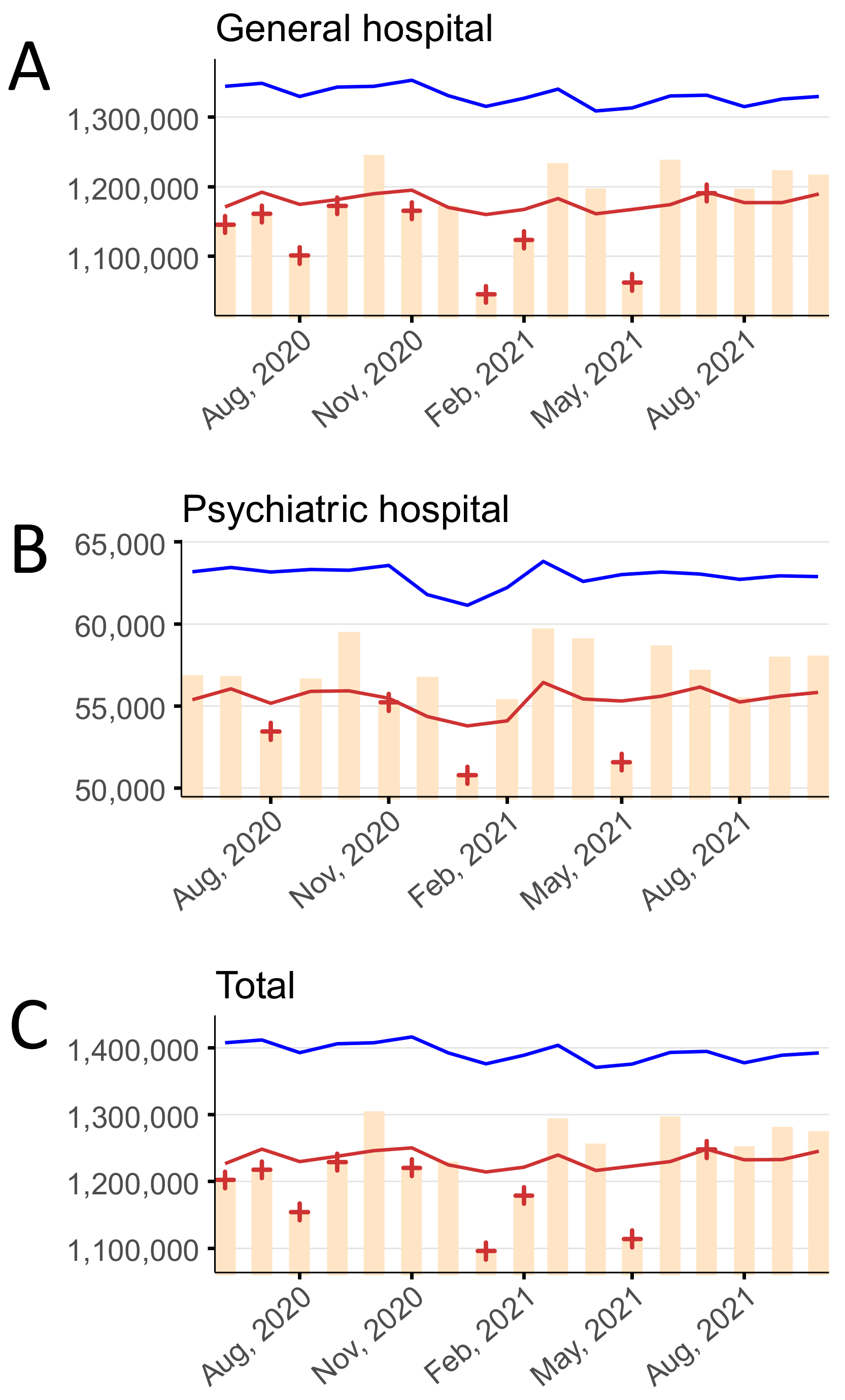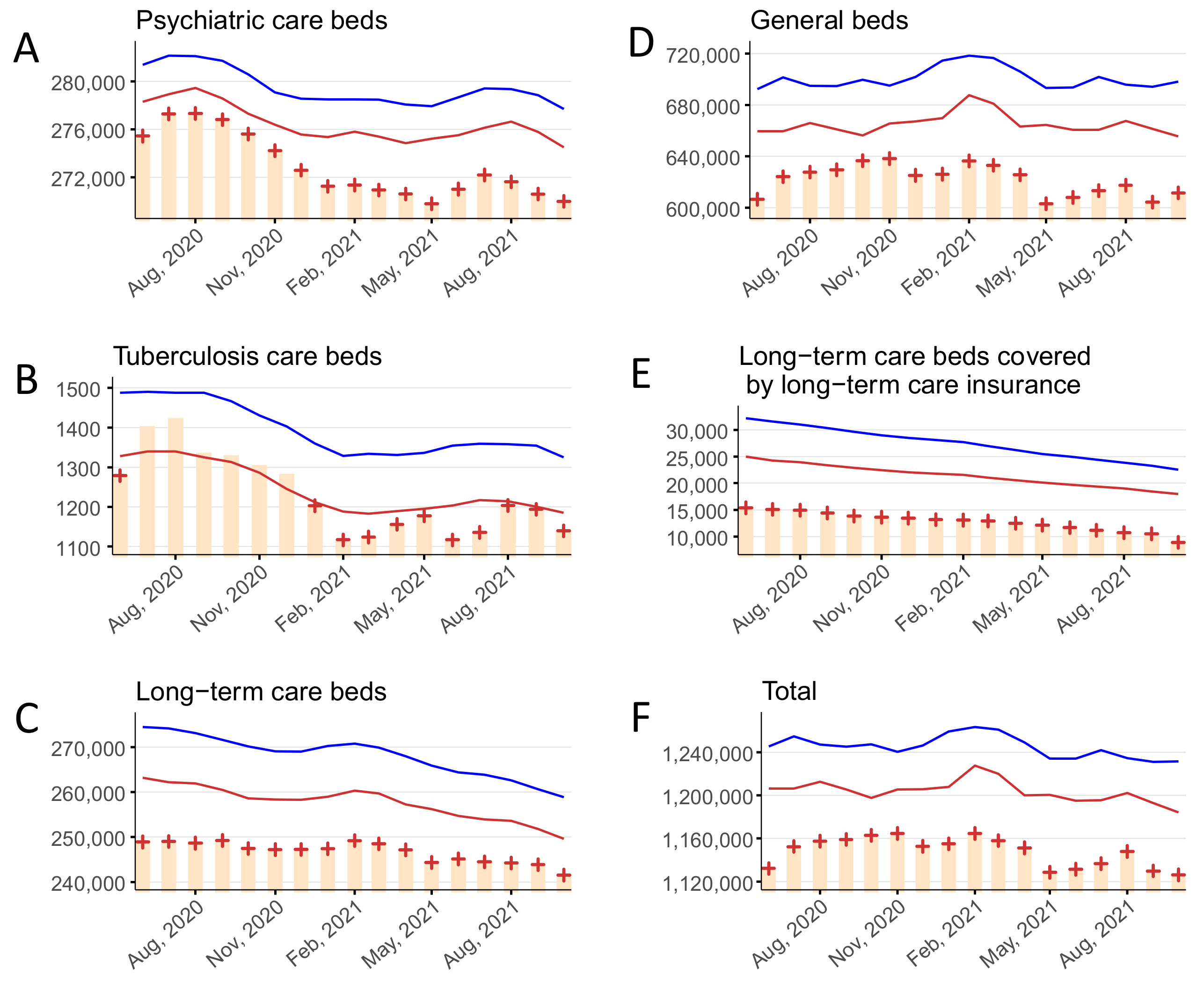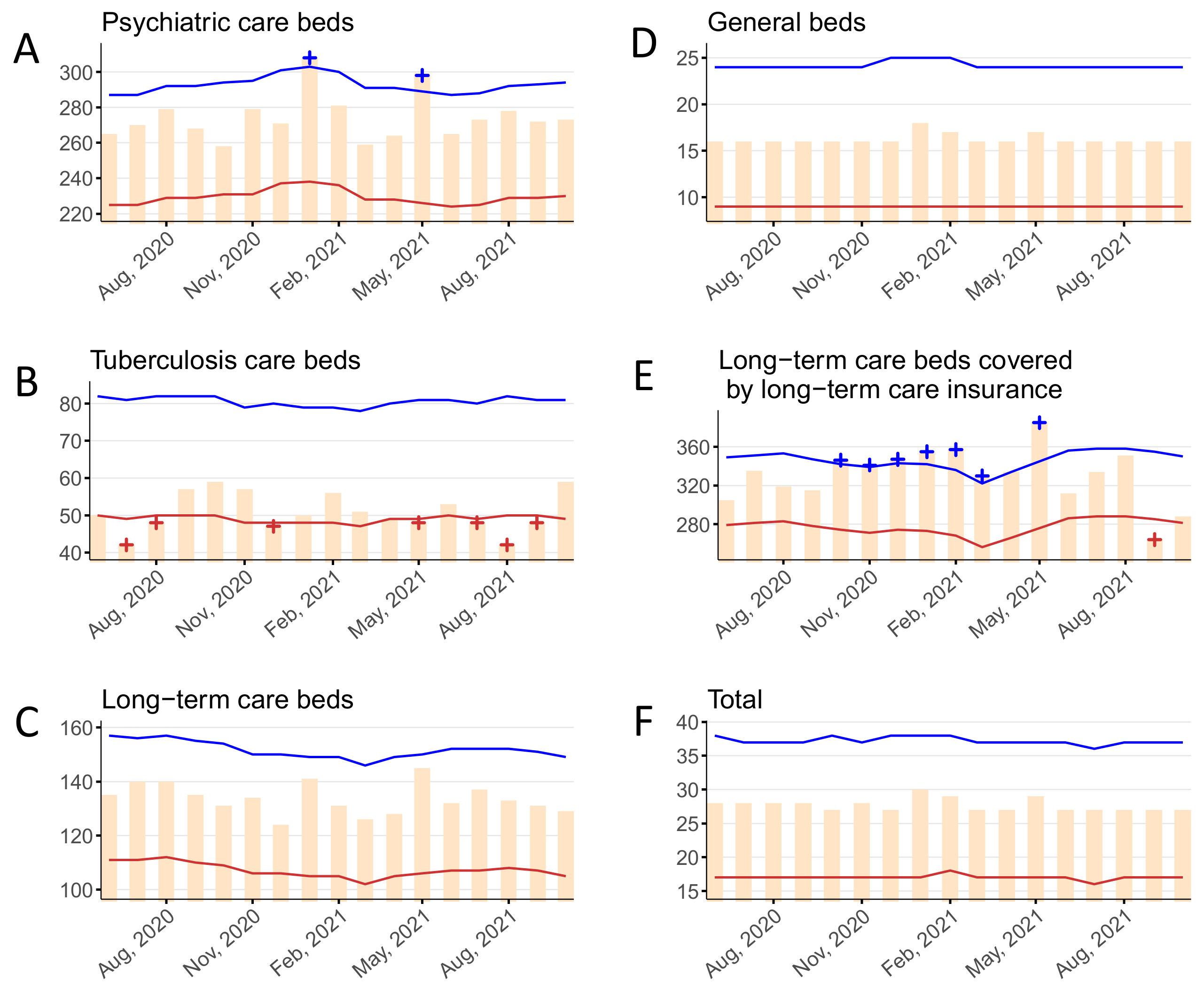Changes in Health Care Access during the COVID-19 Pandemic: Estimates of National Japanese Data, June 2020–October 2021
Abstract
:1. Introduction
1.1. Background
1.2. Objectives
2. Materials and Methods
2.1. Data
2.2. Statistical Approach
3. Results
3.1. Number of Oupatients
3.2. Number of Inpatients
3.3. Hospital Stay
3.4. New Hospitalizations
4. Discussion
5. Conclusions
Supplementary Materials
Author Contributions
Funding
Institutional Review Board Statement
Informed Consent Statement
Data Availability Statement
Conflicts of Interest
References
- Okereke, M.; Ukor, N.A.; Adebisi, Y.A.; Ogunkola, I.O.; Iyagbaye, E.F.; Owhor, G.A.; Iii, D.E.L. Impact of COVID-19 on access to healthcare in low- and middle-income countries: Current evidence and future recommendations. Int. J. Health Plan. Manag. 2020, 36, 13–17. [Google Scholar] [CrossRef]
- Mattingly, A.S.; Rose, L.; Eddington, H.S.; Trickey, A.W.; Cullen, M.R.; Morris, A.M.; Wren, S.M. Trends in US Surgical Procedures and Health Care System Response to Policies Curtailing Elective Surgical Operations During the COVID-19 Pandemic. JAMA Netw. Open 2021, 4, e2138038. [Google Scholar] [CrossRef]
- Prasad, N.K.; Englum, B.R.; Turner, D.J.; Lake, R.; Siddiqui, T.; Mayorga-Carlin, M.; Sorkin, J.D.; Lal, B.K. A Nation-Wide Review of Elective Surgery and COVID-Surge Capacity. J. Surg. Res. 2021, 267, 211–216. [Google Scholar] [CrossRef] [PubMed]
- Uimonen, M.; Kuitunen, I.; Paloneva, J.; Launonen, A.P.; Ponkilainen, V.; Mattila, V.M. The impact of the COVID-19 pandemic on waiting times for elective surgery patients: A multicenter study. PLoS ONE 2021, 16, e0253875. [Google Scholar] [CrossRef] [PubMed]
- Whaley, C.M.; Pera, M.F.; Cantor, J.; Chang, J.; Velasco, J.; Hagg, H.K.; Sood, N.; Bravata, D.M. Changes in Health Services Use Among Commercially Insured US Populations During the COVID-19 Pandemic. JAMA Netw. Open 2020, 3, e2024984. [Google Scholar] [CrossRef] [PubMed]
- Becker, N.V.; Moniz, M.H.; Tipirneni, R.; Dalton, V.K.; Ayanian, J.Z. Utilization of Women’s Preventive Health Services During the COVID-19 Pandemic. JAMA Health Forum 2021, 2, e211408. [Google Scholar] [CrossRef]
- Chen, R.C.; Haynes, K.; Du, S.; Barron, J.; Katz, A.J. Association of Cancer Screening Deficit in the United States With the COVID-19 Pandemic. JAMA Oncol. 2021, 7, 878. [Google Scholar] [CrossRef]
- DeGroff, A.; Miller, J.; Sharma, K.; Sun, J.; Helsel, W.; Kammerer, W.; Rockwell, T.; Sheu, A.; Melillo, S.; Uhd, J.; et al. COVID-19 impact on screening test volume through the National Breast and Cervical Cancer early detection program, January–June 2020, in the United States. Prev. Med. 2021, 151, 106559. [Google Scholar] [CrossRef]
- Ghaznavi, C.; Tanoue, Y.; Kawashima, T.; Eguchi, A.; Yoneoka, D.; Sakamoto, H.; Ueda, P.; Ishikane, M.; Ando, N.; Miyazato, Y.; et al. Recent changes in the reporting of STIs in Japan during the COVID-19 pandemic. Sex. Transm. Infect. 2022, 1–4. [Google Scholar] [CrossRef]
- White, J.; Cavenagh, D.; Byles, J.; Mishra, G.; Tooth, L.; Loxton, D.; Bmath, D.C. The experience of delayed health care access during the COVID 19 pandemic in Australian women: A mixed methods exploration. Health Soc. Care Community 2021, 30, e1384–e1395. [Google Scholar] [CrossRef]
- Nomura, S.; Eguchi, A.; Yoneoka, D.; Kawashima, T.; Tanoue, Y.; Murakami, M.; Sakamoto, H.; Maruyama-Sakurai, K.; Gilmour, S.; Shi, S.; et al. Reasons for being unsure or unwilling regarding intention to take COVID-19 vaccine among Japanese people: A large cross-sectional national survey. Lancet Reg. Health-West. Pac. 2021, 14, 100223. [Google Scholar] [CrossRef] [PubMed]
- Czeisler, M.E.; Marynak, K.; Clarke, K.E.N.; Salah, Z.; Shakya, I.; Thierry, J.M.; Ali, N.; McMillan, H.; Wiley, J.F.; Weaver, M.D.; et al. Delay or Avoidance of Medical Care Because of COVID-19-Related Concerns—United States, June 2020. MMWR Morb. Mortal. Wkly. Rep. 2020, 69, 1250–1257. [Google Scholar] [CrossRef] [PubMed]
- Czeisler, M.E.; Barrett, C.E.; Siegel, K.R.; Weaver, M.D.; Czeisler, C.A.; Rajaratnam, S.M.W.; Howard, M.E.; Bullard, K.M. Health Care Access and Use Among Adults with Diabetes During the COVID-19 Pandemic—United States, February-March 2021. MMWR Morb. Mortal. Wkly. Rep. 2021, 70, 1597–1602. [Google Scholar] [CrossRef] [PubMed]
- Collaborators, C.-E.M. Estimating excess mortality due to the COVID-19 pandemic: A systematic analysis of COVID-19-related mortality, 2020–2021. Lancet 2022, 399, 1513–1536. [Google Scholar]
- Onozuka, D.; Tanoue, Y.; Nomura, S.; Kawashima, T.; Yoneoka, D.; Eguchi, A.; Ng, C.F.S.; Matsuura, K.; Shi, S.; Makiyama, K.; et al. Reduced mortality during the COVID-19 outbreak in Japan, 2020: A two-stage interrupted time-series design. Int. J. Epidemiol. 2021, 51, 75–84. [Google Scholar] [CrossRef]
- Oshitani, H. COVID lessons from Japan: The right messaging empowers citizens. Nature 2022, 605, 589. [Google Scholar] [CrossRef]
- Nomura, S.; Tanoue, Y.; Yoneoka, D.; Gilmour, S.; Kawashima, T.; Eguchi, A.; Miyata, H. Mobility Patterns in Different Age Groups in Japan during the COVID-19 Pandemic: A Small Area Time Series Analysis through March 2021. J. Hered. 2021, 98, 635–641. [Google Scholar] [CrossRef]
- Ghaznavi, C.; Yoneoka, D.; Tanoue, Y.; Gilmour, S.; Kawashima, T.; Eguchi, A.; Kawamura, Y.; Miyata, H.; Nomura, S. Inter-Prefectural Travel and Network Connectedness During the COVID-19 Pandemic in Japan. J. Epidemiol. 2022, JE20220064. [Google Scholar] [CrossRef]
- Makiyama, K.; Kawashima, T.; Nomura, S.; Eguchi, A.; Yoneoka, D.; Tanoue, Y.; Kawamura, Y.; Sakamoto, H.; Gilmour, S.; Shi, S.; et al. Trends in Healthcare Access in Japan during the First Wave of the COVID-19 Pandemic, up to June 2020. Int. J. Environ. Res. Public Health 2021, 18, 3271. [Google Scholar] [CrossRef]
- Toyo Keizai Online COVID-19 Task Team. Coronavirus Disease (COVID-19) Situation Report in Japan. Available online: https://toyokeizai.net/sp/visual/tko/covid19/en.html (accessed on 16 February 2022).
- Nomura, S.; Eguchi, A.; Tanoue, Y.; Yoneoka, D.; Kawashima, T.; Suzuki, M.; Hashizume, M. Excess deaths from COVID-19 in Japan and 47 prefectures from January through June 2021. Public Health 2021, 203, 15–18. [Google Scholar] [CrossRef]
- Japan Excess Deaths Study Group. Excess and Exiguous Deaths Dashboard in Japan. Available online: https://exdeaths-japan.org/en/. (accessed on 13 July 2022).
- OECD. Hospital Beds and Occupancy. Available online: https://www.oecd-ilibrary.org/sites/e5a80353-en/index.html?itemId=/content/component/e5a80353-en#:~:text=Across%20OECD%20countries%2C%20there%20were,)%2C%20rates%20were%20much%20higher (accessed on 19 May 2022).
- OECD. Length of Hospital Stay. Available online: https://www.oecd-ilibrary.org/social-issues-migration-health/length-of-hospital-stay/indicator/english_8dda6b7a-en (accessed on 25 May 2022).
- GBD Healthcare Access; Quality Collaborators. Measuring performance on the Healthcare Access and Quality Index for 195 countries and territories and selected subnational locations: A systematic analysis from the Global Burden of Disease Study 2016. Lancet 2018, 391, 2236–2271. [Google Scholar] [CrossRef]
- Ministry of Health Labour and Welfare. 2010 Summary of Static/Dynamic Surveys of Medical Institutions and Hospital Report; MHLW: Tokyo, Japan, 2011. [Google Scholar]
- CDC. Excess Deaths Associated with COVID-19. Available online: https://www.cdc.gov/nchs/nvss/vsrr/covid19/excess_deaths.htm (accessed on 18 May 2022).
- Kawashima, T.; Nomura, S.; Tanoue, Y.; Yoneoka, D.; Eguchi, A.; Ng, C.F.S.; Matsuura, K.; Shi, S.; Makiyama, K.; Uryu, S.; et al. Excess All-Cause Deaths during Coronavirus Disease Pandemic, Japan, January–May 2020. Emerg. Infect. Dis. 2021, 27, 789–795. [Google Scholar] [CrossRef] [PubMed]
- Noufaily, A.; Enki, D.G.; Farrington, P.; Garthwaite, P.; Andrews, N.; Charlett, A. An improved algorithm for outbreak detection in multiple surveillance systems. Stat. Med. 2013, 32, 1206–1222. [Google Scholar] [CrossRef] [Green Version]
- Farrington, C.P.; Andrews, N.J.; Beale, A.D.; Catchpole, M.A. A Statistical Algorithm for the Early Detection of Outbreaks of Infectious Disease. J. R. Stat. Soc. Ser. A 1996, 159, 547–563. [Google Scholar] [CrossRef]
- Gem Med. Nationwide Hospital Outpatient Operations Restricted 10.4% and Outpatient Operations Suspended 0.8% due to New Coronas, while Normal Operations Were 88.8% for Hospital Outpatient Operations and 91.2% for Hospital Inpatient Operations-MHLW and Cabinet Secretariat. Gem. Med. 11 December. (In Japanese)
- Ministry of Health Labour and Welfare. Securing Inpatient Beds for COVID-19 Patients. Available online: https://www.mhlw.go.jp/content/10900000/000593853.pdf (accessed on 23 May 2022). (In Japanese).
- Ibuka, Y. A study on the medical care delivery system for COVID-19. Nihon Rodo Kenkyu Zasshi 2021, 63, 20–24. (In Japanese) [Google Scholar]
- Ikeda, N.; Yamamoto, H.; Taketomi, A.; Hibi, T.; Ono, M.; Niikura, N.; Sugitani, I.; Isozumi, U.; Miyata, H.; Nagano, H.; et al. The impact of COVID-19 on surgical procedures in Japan: Analysis of data from the National Clinical Database. Surg. Today 2021, 52, 22–35. [Google Scholar] [CrossRef]
- Hibiya, K.; Iwata, H.; Kinjo, T.; Shinzato, A.; Tateyama, M.; Ueda, S.; Fujita, J. Incidence of common infectious diseases in Japan during the COVID-19 pandemic. PLoS ONE 2022, 17, e0261332. [Google Scholar] [CrossRef]
- Visca, D.; Ong, C.; Tiberi, S.; Centis, R.; D’Ambrosio, L.; Chen, B.; Mueller, J.; Duarte, R.; Dalcolmo, M.; Sotgiu, G.; et al. Tuberculosis and COVID-19 interaction: A review of biological, clinical and public health effects. Pulmonology 2021, 27, 151–165. [Google Scholar] [CrossRef]
- Nakagawa, I.; Miyazaki, A. Focus: Surge in COVID-19 Patients, Possibility of Reviewing Plan to Reduce Hospital Beds, Policy Contradictions Exposed. Reuters, 15 April 2020. (In Japanese) [Google Scholar]
- Ministry of Health Labour and Welfare. Long-Term Care Medical Centers. Available online: https://www.mhlw.go.jp/stf/seisakunitsuite/bunya/0000196478.html (accessed on 20 May 2022). (In Japanese).
- Bojdani, E.; Rajagopalan, A.; Chen, A.; Gearin, P.; Olcott, W.; Shankar, V.; Cloutier, A.; Solomon, H.; Naqvi, N.Z.; Batty, N.; et al. COVID-19 Pandemic: Impact on psychiatric care in the United States. Psychiatry Res. 2020, 289, 113069. [Google Scholar] [CrossRef]
- Cao, Y.; Yisimayi, A.; Jian, F.; Song, W.; Xiao, T.; Wang, L.; Du, S.; Wang, J.; Li, Q.; Chen, X.; et al. BA.2.12.1, BA.4 and BA.5 escape antibodies elicited by Omicron infection. Nature 2022, 1–3. [Google Scholar] [CrossRef]




Publisher’s Note: MDPI stays neutral with regard to jurisdictional claims in published maps and institutional affiliations. |
© 2022 by the authors. Licensee MDPI, Basel, Switzerland. This article is an open access article distributed under the terms and conditions of the Creative Commons Attribution (CC BY) license (https://creativecommons.org/licenses/by/4.0/).
Share and Cite
Tanoue, Y.; Ghaznavi, C.; Kawashima, T.; Eguchi, A.; Yoneoka, D.; Nomura, S. Changes in Health Care Access during the COVID-19 Pandemic: Estimates of National Japanese Data, June 2020–October 2021. Int. J. Environ. Res. Public Health 2022, 19, 8810. https://doi.org/10.3390/ijerph19148810
Tanoue Y, Ghaznavi C, Kawashima T, Eguchi A, Yoneoka D, Nomura S. Changes in Health Care Access during the COVID-19 Pandemic: Estimates of National Japanese Data, June 2020–October 2021. International Journal of Environmental Research and Public Health. 2022; 19(14):8810. https://doi.org/10.3390/ijerph19148810
Chicago/Turabian StyleTanoue, Yuta, Cyrus Ghaznavi, Takayuki Kawashima, Akifumi Eguchi, Daisuke Yoneoka, and Shuhei Nomura. 2022. "Changes in Health Care Access during the COVID-19 Pandemic: Estimates of National Japanese Data, June 2020–October 2021" International Journal of Environmental Research and Public Health 19, no. 14: 8810. https://doi.org/10.3390/ijerph19148810
APA StyleTanoue, Y., Ghaznavi, C., Kawashima, T., Eguchi, A., Yoneoka, D., & Nomura, S. (2022). Changes in Health Care Access during the COVID-19 Pandemic: Estimates of National Japanese Data, June 2020–October 2021. International Journal of Environmental Research and Public Health, 19(14), 8810. https://doi.org/10.3390/ijerph19148810




